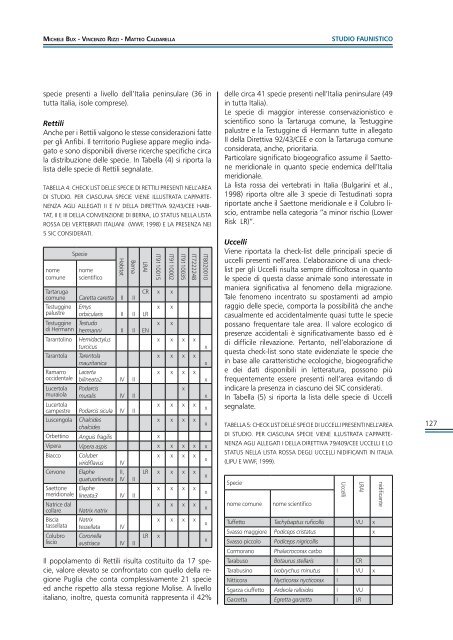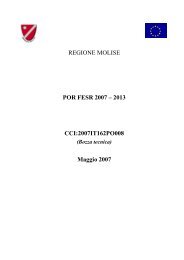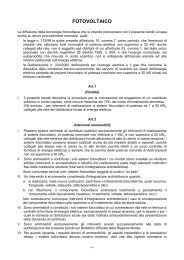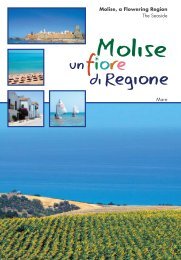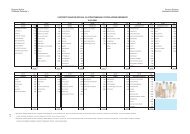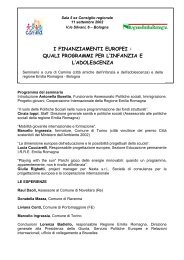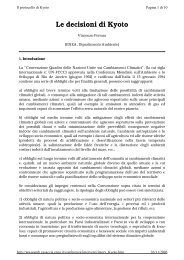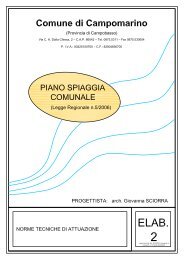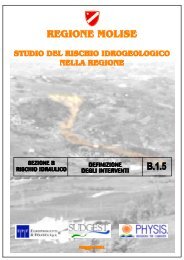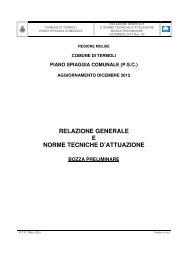Il fiume Fortore - Studi preliminari al piano di gestione dei SIC
Il fiume Fortore - Studi preliminari al piano di gestione dei SIC
Il fiume Fortore - Studi preliminari al piano di gestione dei SIC
Create successful ePaper yourself
Turn your PDF publications into a flip-book with our unique Google optimized e-Paper software.
Mi c he l e Bu x - Vin c e n z o Rizzi - Mat t e o C<strong>al</strong>darella<br />
STUDIO FAUNISTICO<br />
specie presenti a livello dell’It<strong>al</strong>ia peninsulare (36 in<br />
tutta It<strong>al</strong>ia, isole comprese).<br />
Rettili<br />
Anche per i Rettili v<strong>al</strong>gono le stesse considerazioni fatte<br />
per gli Anfibi. <strong>Il</strong> territorio Pugliese appare meglio indagato<br />
e sono <strong>di</strong>sponibili <strong>di</strong>verse ricerche specifiche circa<br />
la <strong>di</strong>stribuzione delle specie. In Tabella (4) si riporta la<br />
lista delle specie <strong>di</strong> Rettili segn<strong>al</strong>ate.<br />
Tabella 4: Check List delle specie <strong>di</strong> Rettili presenti nell’area<br />
<strong>di</strong> stu<strong>di</strong>o. Per ciascuna specie viene illustrata l’appartenenza<br />
agli <strong>al</strong>legati II e IV della Direttiva 92/43/CEE Habitat,<br />
II e III della Convenzione <strong>di</strong> Berna, lo status nella Lista<br />
Rossa <strong>dei</strong> Vertebrati it<strong>al</strong>iani (WWF, 1998) e la presenza nei<br />
5 <strong>SIC</strong> considerati.<br />
nome<br />
comune<br />
Specie<br />
nome<br />
scientifico<br />
Habitat<br />
Berna<br />
Tartaruga<br />
comune Caretta caretta II II<br />
Testuggine<br />
p<strong>al</strong>ustre<br />
LRAI<br />
Emys<br />
orbicularis II II LR<br />
Testuggine<br />
<strong>di</strong> Hermann Testudo<br />
hermanni II II EN<br />
Tarantolino Hemidactylus<br />
turcicus<br />
Tarantola Tarentola<br />
mauritanica<br />
Ramarro<br />
occident<strong>al</strong>e<br />
Lucertola<br />
muraiola<br />
Lacerta<br />
bilineata2 IV II<br />
Podarcis<br />
mur<strong>al</strong>is IV II<br />
Lucertola<br />
campestre Podarcis sicula IV II<br />
IT9110015<br />
IT9110002<br />
CR x x<br />
x<br />
x<br />
x<br />
x<br />
IT9110035<br />
IT7222248<br />
x x x x<br />
x x x x<br />
x x x x<br />
x<br />
x x x x<br />
Luscengola Ch<strong>al</strong>cides<br />
x x x x<br />
ch<strong>al</strong>cides<br />
x<br />
Orbettino Anguis fragilis x<br />
Vipera Vipera aspis x x x x x<br />
Biacco Coluber<br />
x x x x<br />
viri<strong>di</strong>flavus IV<br />
x<br />
Cervone<br />
Saettone<br />
meri<strong>di</strong>on<strong>al</strong>e<br />
Natrice d<strong>al</strong><br />
collare<br />
Biscia<br />
tassellata<br />
Colubro<br />
liscio<br />
Elaphe<br />
quatuorlineata<br />
II,<br />
IV<br />
Elaphe<br />
lineata3 IV II<br />
Natrix natrix<br />
Natrix<br />
tessellata<br />
IV<br />
Coronella<br />
austriaca IV II<br />
II<br />
LR x x x x<br />
x x x x<br />
x x x x<br />
x x x x<br />
IT8020010<br />
<strong>Il</strong> popolamento <strong>di</strong> Rettili risulta costituito da 17 specie,<br />
v<strong>al</strong>ore elevato se confrontato con quello della regione<br />
Puglia che conta complessivamente 21 specie<br />
ed anche rispetto <strong>al</strong>la stessa regione Molise. A livello<br />
it<strong>al</strong>iano, inoltre, questa comunità rappresenta il 42%<br />
LR<br />
x<br />
x<br />
x<br />
x<br />
x<br />
x<br />
x<br />
x<br />
x<br />
x<br />
x<br />
delle circa 41 specie presenti nell’It<strong>al</strong>ia peninsulare (49<br />
in tutta It<strong>al</strong>ia).<br />
Le specie <strong>di</strong> maggior interesse conservazionistico e<br />
scientifico sono la Tartaruga comune, la Testuggine<br />
p<strong>al</strong>ustre e la Testuggine <strong>di</strong> Hermann tutte in <strong>al</strong>legato<br />
II della Direttiva 92/43/CEE e con la Tartaruga comune<br />
considerata, anche, prioritaria.<br />
Particolare significato biogeografico assume il Saettone<br />
meri<strong>di</strong>on<strong>al</strong>e in quanto specie endemica dell’It<strong>al</strong>ia<br />
meri<strong>di</strong>on<strong>al</strong>e.<br />
La lista rossa <strong>dei</strong> vertebrati in It<strong>al</strong>ia (Bulgarini et <strong>al</strong>.,<br />
1998) riporta oltre <strong>al</strong>le 3 specie <strong>di</strong> Testu<strong>di</strong>nati sopra<br />
riportate anche il Saettone meri<strong>di</strong>on<strong>al</strong>e e il Colubro liscio,<br />
entrambe nella categoria “a minor rischio (Lower<br />
Risk LR)”.<br />
Uccelli<br />
Viene riportata la check-list delle princip<strong>al</strong>i specie <strong>di</strong><br />
uccelli presenti nell’area. L’elaborazione <strong>di</strong> una checklist<br />
per gli Uccelli risulta sempre <strong>di</strong>fficoltosa in quanto<br />
le specie <strong>di</strong> questa classe anim<strong>al</strong>e sono interessate in<br />
maniera significativa <strong>al</strong> fenomeno della migrazione.<br />
T<strong>al</strong>e fenomeno incentrato su spostamenti ad ampio<br />
raggio delle specie, comporta la possibilità che anche<br />
casu<strong>al</strong>mente ed accident<strong>al</strong>mente quasi tutte le specie<br />
possano frequentare t<strong>al</strong>e area. <strong>Il</strong> v<strong>al</strong>ore ecologico <strong>di</strong><br />
presenze accident<strong>al</strong>i è significativamente basso ed è<br />
<strong>di</strong> <strong>di</strong>fficile rilevazione. Pertanto, nell’elaborazione <strong>di</strong><br />
questa check-list sono state evidenziate le specie che<br />
in base <strong>al</strong>le caratteristiche ecologiche, biogeografiche<br />
e <strong>dei</strong> dati <strong>di</strong>sponibili in letteratura, possono più<br />
frequentemente essere presenti nell’area evitando <strong>di</strong><br />
in<strong>di</strong>care la presenza in ciascuno <strong>dei</strong> <strong>SIC</strong> considerati.<br />
In Tabella (5) si riporta la lista delle specie <strong>di</strong> Uccelli<br />
segn<strong>al</strong>ate.<br />
Tabella 5: Check List delle specie <strong>di</strong> Uccelli presenti nell’area<br />
<strong>di</strong> stu<strong>di</strong>o. Per ciascuna specie viene illustrata l’appartenenza<br />
agli <strong>al</strong>legati I della Direttiva 79/409/CEE Uccelli e lo<br />
status nella Lista Rossa degli Uccelli ni<strong>di</strong>ficanti in It<strong>al</strong>ia<br />
(LIPU e WWF, 1999).<br />
Specie<br />
nome comune<br />
nome scientifico<br />
Uccelli<br />
LRAI<br />
Tuffetto Tachybaptus ruficollis VU x<br />
Svasso maggiore Po<strong>di</strong>ceps cristatus x<br />
Svasso piccolo Po<strong>di</strong>ceps nigricollis<br />
Cormorano Ph<strong>al</strong>acrocorax carbo<br />
Tarabuso Botaurus stellaris I CR<br />
Tarabusino Ixobrychus minutus I VU x<br />
Nitticora Nycticorax nycticorax I<br />
Sgarza ciuffetto Ardeola r<strong>al</strong>loides I VU<br />
Garzetta Egretta garzetta I LR<br />
ni<strong>di</strong>ficante<br />
127


